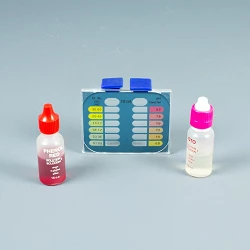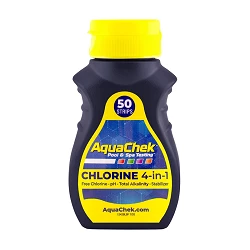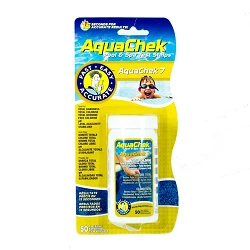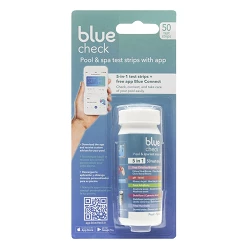CL-PH analyser kit quimicamp

- Basic cl-ph analyser kit Quimicamp
- Easy to use, ideal for private pools
- Essential for chlorine and ph water control
- A balanced water balance is essential for an optimal swimming pool
- Liquid reagent for colouring
Bought together Usually
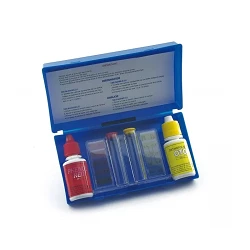 Actual product
Actual product
Technical characteristics
Analyser Quimicamp
Basic kit for analysing the chlorine and pH of the pool water by means of drops. We remind you that at high pH levels the effectiveness of chlorine is substantially reduced.
what is balanced water?
It is the pool water whose parameters.
- Hardness.
- Total alkalinity.
- pH.
- Free chlorine.
- Stabiliser concentration.
They are correctly adjusted, being impossible to have water in perfect conditions of transparency and disinfection, if it is not totally BALANCED.
Sampling for the determination of these parameters shall be carried out far from the discharge outlets and at a depth of 30 cm.
1) Hardness.
- This is the amount of calcium dissolved in the water.
Ideal amount of calcium.
- 175 to 300 ppm (CaCO3).
But it is possible to reach up to 1,000 ppm, provided that the total amount and pH are properly adjusted.
Calcium deficiency causes:
- Pitting on the surface of the pool shell.
- Corrosion of metal parts and pool accessories.
Excess calcium leads to:
- Cloudy water.
- Stained surfaces.
- Scale formation.
how to adjust the hardness?
- 150 grams of CTX-22 per M3 of water is sufficient to increase the hardness by 10 ppm.
To lower the hardness, part of the pool is emptied and new water, low in calcium content, is introduced.
It is interesting to check and adjust the hardness once a month.
2) Total Alkalinity.
- This is the amount of carbonates and hydroxides in your pool water.
Ideal amount of alkalinity:
- 125 to 150 ppm.
Alkalinity deficiency causes:
- Corrosion and staining of metal parts and pool accessories.
- Difficult pH control
Excess alkalinity causes:
- Increased pH.
- Cloudy water.
- Irritation of the eyes, ears, nose and throat of bathers.
- Formation of incrustations on the pool walls and fittings.
how to adjust the total alkalinity?
If the total alkalinity of your pool is too high, it can be lowered by adding CTX-10. 150 grams of CTX-10 for every M3 of water will lower the total alkalinity by 10 ppm.
If the total alkalinity of your pool is too low, it can be increased by adding CTX-21, 180 grams of CTX-21 for every M3 of water will increase the total alkalinity by 10 ppm, it is necessary to adjust the total alkalinity of the water once a week.
It is important that once the total alkalinity has been adjusted, allow 48 hours to elapse and then adjust the pH.
3) pH.
- The pH is a measure of the acidity or basicity of the water. Water with a pH value less than 7 is acidic.
- Water with a pH value greater than 7 is basic.
Ideal pH value.
- 7.2 - 7.6.
Too low a pH value will result in:
- Corrosion of metals and pool accessories.
- Irritation of the eyes, ears, nose and throat of bathers.
Too high a pH will result in:
- Turbidity in the water.
- Formation of scale or incrustations.
- Irritation of the eyes, ears, nose and throat of bathers.
- It hinders and delays the effectiveness of the disinfectant responsible for eliminating micro-organisms from the water.
how to adjust the pH?
- If the pH of your water is lower than 7.2, add CTX-20 to increase the pH. 150 grams of CTX-20 will produce a pH increase of approximately 0.2 per M3 of water.
- If the pH of your water is above 7.6, add CTX-10 to decrease the pH. 150 g of CTX-10 will produce a decrease of approximately 0.2 per 10 M3 of water.
- Check and, if necessary, adjust the pH of the water daily.
4) Free Chlorine.
Free chlorine is the amount of active chlorine available to kill new micro-organisms introduced into the pool water. Too low a free chlorine residual (less than 1 ppm.) will allow bacteria and algae to grow in the water, causing unhygienic and unpleasant conditions. It is important to always maintain a minimum free chlorine residual of 1 ppm.
The exact amount of chlorine product needed to maintain the required 1 ppm free chlorine residual varies with the number of bathers, sunlight, air pollution and other factors.
Bathers should not use the pool when the pool water contains a free chlorine residual greater than 3 ppm.
The best time for the addition of chemicals is at night and when the pool is not in use.
The free chlorine residual should be checked at least twice a day.
5) Stabiliser concentration.
The most frequently used stabiliser in swimming pools today is cyanuric acid.
Ideal amount of stabiliser.
- Maintain a cyanuric acid level of 30 to 50 ppm.
- The concentration of cyanuric acid should not exceed 75 ppm.
- Too high a concentration will retard the efficacy of the disinfectant.
how to adjust the concentration of the stabiliser?
- 200 g of CTX-400 per M3 of water will increase the concentration of cyanuric acid by approximately 20 ppm.
- If the concentration of cyanuric acid increases too much, drain the pool by replacing part of this water with new water that does not contain cyanuric acid.
The cyanoisocyanuric compounds contain cyanuric acid and their use will contribute to a continuous increase in the concentration of the stabiliser.
It is interesting to check and adjust the concentration of the stabiliser once a week.
Data Sheet
- Format
- Liquid
- Type of case
- Manual
Verified Reviews
DIDIER S. published the 13/07/2023 following an order made on 17/06/2023
Perfecto !!!!
Julio C. published the 21/06/2023 following an order made on 01/06/2023
Como en descripción.
Anonymous customer published the 31/08/2021 following an order made on 25/08/2021
Analizador agua piscina
Anonymous customer published the 03/07/2021 following an order made on 27/06/2021
Cumple su cometido
Anonymous customer published the 10/05/2020 following an order made on 02/05/2020
Buen producto
Anonymous customer published the 26/04/2018 following an order made on 26/04/2018
Utilizo el producto para el uso indicado y lo recomiendo a quien tenga dudas del nivel de cal en el agua de su piscina. He comparado con otra marca que vengo usando y ambos dan resultados similare, osea calidad adecuada.
Might Also like











